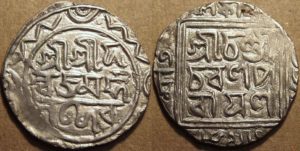Taka and its Historical Asian Journey

Tanka with Bengali script; thought to be from the Bengali Sultanate era. (Source: CoinIndia)
Taka, the currency of Bangladesh, has faced much financial turmoil as of late. Bangladesh has been dramatically impacted as the global economy suffers one of the worst slowdowns since the 2009 financial crisis. Devaluation and inflation hit a record high in August with exchange rates peaking at 119 Tk to the US Dollar.
However, just last year, the International Monetary Fund declared that Bangladesh might soon surpass Denmark and Singapore in its gross domestic product. The World Bank has called Bangladesh’s growth in the past 50 years, once thought of as a “basket case,” “a remarkable story of poverty reduction and development”.
Indeed, until recently, the taka has a history of defiance and resilience, a history that extends far beyond 1971. The modern Bangladeshi taka actually descends from the historical tanka, the Sanskrit word for ‘stamped coin,’ which dates as far back as the 14th century. Once one of the major currencies became used beyond Bengal or the subcontinent, the tanka was used along the Silk Road as well as in established trade networks in the Indian Ocean.
As a result of its usage across various regions, the tanka was also inscribed in Sanskrit, Arabic, Persian, Hindustani, Bengali, Nepali, Tibetan and Mandarin. The currency stronghold originated and remained in Bengal throughout this time, however, under the Delhi Sultanate, which was later succeeded by the Bengal Sultanate, the Bahmani Sultanate and the Gujarat Sultanate in the 15th century. Even during the rule of the Mughals in the 16th century, changing currencies were still regionally referred to as tanka.
Introduced by Muhammad Bin Tughluq, the emperor of the Delhi Sultanate, in 1329, the currency was known officially as the Imperial tanka as well as Sultani tanka. Rather than using gold and silver as precious metals were in short supply, tanka was initially minted in copper and brass instead. The new currency followed the revolutionary concept of representative paper money, first pioneered by the Chinese in the 7th century. In contrast, the first banknotes did not appear in Europe until the 17th century.
Moreover, Ibn Battuta, the famed Maghrebi scholar and explorer, noted the significance of the tanka on a visit to Bengal in 1338. He observed that in the marketplace, gold and silver dinars, the once popular currency of the Islamicate world, were often referred to in terms of tanka. The dominance of the tanka grew so strong that the Sultans of Bengal, in hopes to strengthen their sovereignty through the symbol of tanka, had 27 mints established. This included mint towns in Pandua and Chittagong.
Outside the subcontinent, the tankas mark reached what is today modern-day Nepal in the 16th century and Tibet in the 17th century. In fact, in Tibet, tanka, minted with Chinese inscriptions, was in use until the 1940’s, after which it was replaced by the Chinese Yuan. Tanka, originally referred to as ancient coinage, often carried different meanings across different regions. For centuries, it may have been connected to specific currency, but tanka developed independently into the Bengal tanka while still bearing the same name.
Nevertheless, the tanka remained influential despite British rule, during which the East India Company and later, the Crown, introduced their own coinage into circulation. In fact, after Partition and until 1971, the Pakistani rupee featured both Urdu as well as Bengali denominations of the tanka. In the first few months after becoming independent, the Pakistani rupee remained in circulation until the first ৳1 banknotes were printed in 1972.
Given the resilient history of the tanka, it is not surprising that Bangladesh inherited the currency. Just as it was a symbol of sovereignty in the past, tanka, now known as taka, came to be central to establishing sovereignty after hard-fought battles for independence. In the years following 1971, various denominations of the taka were introduced. The ৳1 coins, specifically, fell out of use and circulation with inflation, which led to ৳1000 taka banknotes being issued for the first time in 2008.
The taka has faced many changes in its lifetime, and with Bangladesh’s current economic troubles, it will no doubt continue to do so. But just as how the taka has survived history, colonialism and war, there is no doubt that the Bangladeshi taka and its people will survive yet another crisis.
